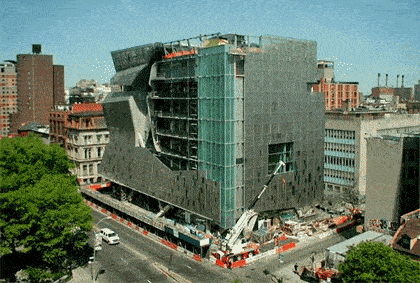State of the Cooper Union
The New York Times features Cooper Union’s latest building in an article by Ada Louise Huxtable.
In an article for the NYTimes, Ada Louise Huxtable describes both the history as well as the desired futures for the Cooper Union New Academic Building in New York City:
Designed by Thom Mayne of Morphosis, a West Coast firm based in Santa Monica, Calif., in association with Gruzen Samton of New York, the bold new arrival has been widely praised by the architectural community and sharply criticized by those who see it as a contextual affront to the neighborhood. This is a disagreement that won’t go away any time soon. A little background may help.
Cooper Union was conceived and founded by the 19th-century inventor, entrepreneur, philanthropist and legendary New Yorker Peter Cooper, who specified that it “should be entirely devoted with all its rents and revenues of every name and nature to the advancement of science and art.” His generous gift of building and land has provided a superior, tuition-free education for generations of distinguished architects, artists and engineers.

Cooper Union building during construction in New York City.
Film courtesy Cooper Union.
Published photographs make the contoured and perforated stainless-steel screen that wraps the structure like a second skin look as if it has been hit by an asteroid. Approached in person, the building is more inviting than alarming. It has a visual and physical power that pulls you across the street to see more.
The screen stops well above the sidewalk, revealing V-shaped concrete supports and a glass-walled ground floor with views of a double-height sunken gallery inside. Operable windows in the perforated mesh and the slashes in the façade open public areas to panoramic city views. At night, lights turn the screen into an illuminated theatrical scrim.
Mr. Mayne has used similar screens as energy-saving devices before; this one promises a 50% reduction in heat load. A full range of such features, from the operable building skin and a planted “green” roof to radiant heating panels and a cogeneration plant, is expected to earn a platinum LEED (Leadership in Energy and Environmental Design) rating from the Green Buildings Council.
Article by Ada Louise Huxtable. Read the full story at Wall Street Journal.



 PHOTO © Tim Hursley
PHOTO © Tim Hursley









 PHOTO ©️ Parrish Ruiz de Velasco (parrch.com)
PHOTO ©️ Parrish Ruiz de Velasco (parrch.com)



 © Fedora Hat Photography
© Fedora Hat Photography Photo by Andre Sigur | ARKO
Photo by Andre Sigur | ARKO





 Ɱ, Creative Commons Attribution-Share Alike 4.0 International license, edited.
Ɱ, Creative Commons Attribution-Share Alike 4.0 International license, edited.


